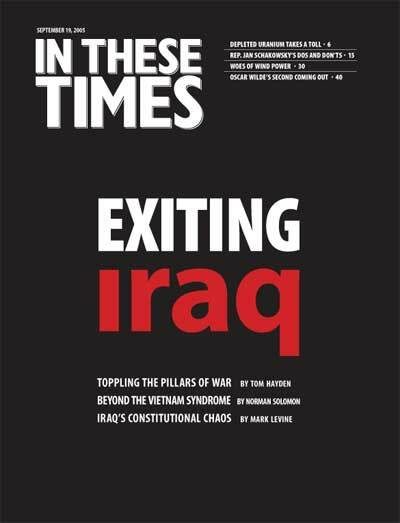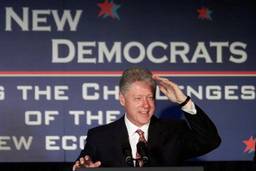
When you’re in the middle of a conflict, you’re trying to find pillars of strength to lean on,” an American officer in Iraq said recently. With those words he provided a clue to ending the war: Undermine the pillars of Pentagon policy through people power.
Those pillars – among them public cooperation, Iraqi cooperation, congressional compliance, centrist caution, military recruitment and U.S. alliances – are weakening.
The time is now
Public support for the war is down, as are the president’s ratings. Antiwar Democrats are coming back. Military recruiting is hitting a wall. The strategy of “Iraqization” is failing. The coalition of the willing is disintegrating. America’s reputation is tattered.
Public sympathy towards Cindy Sheehan suggests a crucial shift in America’s sensibility toward the losses. Usually wars generate a public reluctance to withdraw without “victory” so that the fallen shall not have “died in vain.” In this case, Sheehan has led much of the country through a grieving process that demands the truth so that no others will die for hollow or fabricated reasons.
Recognizing its weaknesses, the administration is on a mission of perception management to gain time and resources. Americans are now being promised that Iraq will have a new constitution, democratic elections and, most importantly, that the first troops may be home by the spring of the 2006 election year.
These gestures are the Bush administration’s responses to the quandaries it is confronting on the battlefields of war and domestic public opinion. They are designed to extend the conflict while appearing to begin disengagement. This ploy is nothing new; we should remember that the Vietnam War continued for seven years after President Johnson was pressured to resign and peace talks began.
“They just keep getting stronger,” the New York Times recently wrote when describing the Iraqi resistance. The Times went on to confirm that over the past year the insurgents have inflicted some 65 attacks on U.S. and Iraqi troops each day, with increasing sophistication and precision. Baghdad is “effectively enemy territory, with an ability to strike at will, and to shake off the losses inflicted by American troops.” American casualties cannot be concealed. During May and June, 71 Americans were killed in 700 attacks; by the year’s end it is likely that 2,000 Americans will have been killed, not counting hundreds of American private contractors. According to Pentagon data, 13,000 Americans have been wounded in battle, more than half of them seriously. Tens of thousands will return with serious mental health problems.
U.S. troops cannot hold the territory they occupy – the classic contradiction faced by an occupying power trying to prop up an unrepresentative regime against a nationalist resistance. The training and deployment of Iraqi counter-insurgency troops – “Iraqization” – has failed so far, according to declassified Pentagon reports. And Defence Secretary Donald Rumsfeld says it may take four, eight, or 12 years – in other words, several more U.S. presidential cycles.
Iraqi antiwar groups rise
The most significant factor on the ground is the rise of an Iraqi movement calling for U.S. withdrawal and the end of the occupation. Rather than welcoming such a development, the administration and a media blinded by its own paradigms have ignored the possibility of a peace process among Iraqis.
Buried in the eleventh paragraph of a July 2005 story about two British contractors dying in Iraq, the Times mentions that supporters of the Shiite cleric Moqtada al-Sadr, famous for two uprisings against American troops, collected one million signatures against the occupation in three weeks. In addition, on June 12 at least 82 members of the Iraqi parliament – one-third of the body – issued a statement calling for the end of occupation and complaining they were not properly consulted in the United Nations Security Council’s recent extension of the occupation.
The rumblings within America’s client regime reflect a widespread consensus on the ground. Surveys taken at the beginning of 2005 show that 82 percent of Sunnis and 69 percent of Shiites favored a near-term U.S. withdrawal. According to the State Department’s own internal surveys, at least half of Iraqis interviewed say they feel unsafe because of the presence of American troops.
Indeed, a former minister in the Iraqi government, Dr. Aiham Al Sammarae, is engaged in peace talks with representatives of at least four insurgent groups. He spoke in Washington in July about his mission, but has received no public acknowledgement by government officials or mainstream reporters. In all likelihood, the Bush administration is struggling to suppress even moderate voices against the occupation. After all, how would the United States respond to a broad-based antiwar movement in Iraq? Call a majority of Iraqis dupes of terrorism?
Most Americans would be relieved at the prospect of peace talks among Iraqis, including the insurgents, aimed at ending the debacle. The situation calls for a negotiated exit strategy, not Rumsfeld’s boastful assertion, “We have no exit strategy, only a victory strategy.”
Nevertheless, the White House will play upon the significant misgivings many Americans feel about the consequences of a sudden pullout. Since Bush has no exit plan, it is important that peace advocates put one forward in the final battle for public opinion.
A provisional exit plan is circulating as a petition to Congress on several peace group Web sites. Its core guidelines include:
- A demand that the United States disavow any plans for permanent military bases or control of Iraqi oil.
- A declaration of intent to end the occupation in months, not years, followed by an initial limited troop withdrawal by December.
- A request that the United Nations take responsibility for military monitoring and the task of economic reconstruction.
- The appointment of an independent peace envoy to undertake the shift from the military model to one of conflict resolution.
- Immediate peace talks with the Iraqi opposition, including insurgents, to begin a political settlement.
If these proposals seem utopian at the moment, the alternative is a continuing hell. The peace movement needs to advocate a peace plan, demand hearings and debate from Congress, and hold do-nothing politicians accountable.
Congress wakes up
Congressional Democrats are begining to take up an exit strategy, both to put the administration on the defensive and to send a positive message to those who are against the war but worried about the consequences of withdrawal.
In the past eight months, the leaders of the Democratic Party were either out-hawking the Republicans or AWOL from the antiwar struggle. But thanks to many local activists and the Progressive Democrats of America, in the past several months Democratic conventions in California, Wisconsin and Massachusetts passed antiwar resolutions, as did the Young Democrats of America. And a courageous handful of Representatives like Lynn Woolsey (D-Calif.), Barbara Lee (D-Calif.), Dennis Kucinich (D-Ohio) and Neal Abercrombie (D-Hawaii) offered withdrawal resolutions. Sen. Ted Kennedy (D-Mass.) was forced by his colleagues in February to withdraw a similar resolution he had introduced in the Senate. Lately, Sen. Russ Feingold (D-Wis.) has taken up the banner of withdrawal by the end of 2006. DNC Chairman Howard Dean has also realized the need for an exit plan, and encouraged congressional hearings.
The changed atmosphere in Washington is symbolized by the public interest in the Downing Street hearings chaired by Rep. John Conyers (D-Mich.), the antiwar stances of a growing number of House Republicans and the increasing number of co-authors on Woolsey’s withdrawal resolution – from 14 to 128. Shortly afterward, Rep. Maxine Waters (D-Calif.) led a backroom rebellion against Minority Leader Rep. Nancy Pelosi’s leadership, forming an “out of Iraq” caucus of more than 60 members.
Tens of thousands will be descending on Washington, D.C. for United For Peace and Justice’s Anti-War Mobilization on September 24, providing an opportunity for the peace movement to further amplify its message.
That would pose a real complication to the administration when it seeks another $80 billion supplemental appropriation sometime after January. At the moment, the reluctance of elected officials to cut the war funds remains the Bush administration’s strongest pillar. But by next year’s election their numbers and their discontent will rise, in direct relation to the voices of protest and frustration they hear in their districts.
A key issue for the antiwar movement will be driving home the budgetary costs of the war to local constituencies in congressional districts. One billion dollars per week could purchase health insurance for 46.4 million people, Head Start enrollments for 27 million kids or 8.6 million four-year college scholarships. Such figures are available up-to-the-minute for every budget category for every state at www.costofwar.com. As people learn the facts being kept from them, public support for further funding will shrink.
Unorthodox alliances
Centrists, moderates or national security types are unlikely to take a strong stand on withdrawal. It is more likely that an antiwar majority will grow from the right and left of the political spectrum.
Together, critics from both sides of the aisle can overcome mainstream caution. The antiwar movement doesn’t need the editorial page of the New York Times if it has an alliance with conservative members of Congress and their constituents. William Buckley and Pat Buchanan are against this war, along with a silent minority in the armed forces. New converts include representatives like Walter Jones (R-N.C.), who once called for re-naming the French fry the “freedom fry.” Having become deeply disturbed by the funerals in his district, Jones has decided to co-author with Democrats a bill calling for a 2006 withdrawal timetable.
The left-right alliance demonstrated its potential at least briefly in June, when the library protection amendment to the Patriot Act passed with 38 Republican votes, causing a White House strategist to warn of “crazies on the left and crazies on the right meeting in the middle.” The rebellion was quelled, but the restless majority is still there, undermining the pillar of the center.
Recruitment hits the wall
The previous generation of the antiwar movement forced an end to the draft. That generation has become the parents of today’s youth, a fact that deeply upsets a Pentagon trying to erase the “Vietnam syndrome.” “The Pentagon is especially vexed by a generation of more activist parents who have no qualms about projecting their own qualms onto their children,” reports the New York Times.
The recruitment crisis is connected to the morale crisis on the battlefield itself. Six thousand American soldiers are AWOL, including 37 military recruiters.
Bush doesn’t have the political capacity to reinstate the draft because that would dramatically broaden the antiwar movement. Nor does he have the political touch to convince hundreds of thousands of military families that their sons and daughters should fight a dubious battle because of a back-door draft. The military itself is his weakest pillar.
The disappearing coalition
The number of coalition members with actual troops on the ground has declined already from 34 to approximately 20 nations. Even Ukraine, after taking millions from the United States for its recent elections, has begun withdrawing its 150 soldiers. The United States’ staunchest allies, the United Kingdom and Italy, are reeling from massive political pressure for troop pullouts. Britain is down from an original 40,000 troop commitment to approximately 8,500 today.
Second to the United States in troop commitments of 138,000 are the 20,000 stateless mercenaries recruited from repressive armies in places like Colombia, El Salvador and South Africa, paid by American taxpayers but exempt from even the minimum controls applied to national armies.
This pillar of international alliances is nearly gone. By next year, it is likely that the American troops will bear the sole burden of the war, an experience in unilateralism that will only deepen soldiers’ questioning.
Iraq as focal point
One by one, the pillars supporting the War in Iraq are toppling. We have all become prisoners, indefinitely detained by a war that was supposed to be swift and cheap.
This doesn’t necessarily mean the war will end. It does mean that the administration, in order to placate voters and buy time in the coming election year, is likely to defuse the rising opposition with partial withdrawals and grudging talks. But the administration’s main goal appears to be to reduce the war’s presence in our lives, to go “off camera, so to speak”, as the neoconservative Robert Kaplan advises. This is the Vietnam strategy that was pursued by the current generation of Republicans in their formative years, when the likes of John Negroponte served under Henry Kissinger. It is pursued today in Afghanistan and Colombia, wars with a minimal number of American casualties that are too expensive – too boring perhaps – for the corporate media to cover.
Iraq is the great exception, the war that can’t be switched off the television. It stands to be the illuminating experience for this generation, the classroom in which the lessons of war, empire and the costs at home will be learned or not.
The way is open for the peace movement – and politicians in the Democratic Party if they choose – to offer an exit strategy and an alternative vision of America’s needs to a majority of Americans. Just as the end of the Vietnam war led the way, at least for a decade, for movements supporting human rights, alternative energy development, and open and democratic government, so we are approaching the time when progressives can offer real alternatives to a new generation of Americans disillusioned by needless deaths in the service of official lies.

I hope you found this article important. Before you leave, I want to ask you to consider supporting our work with a donation. In These Times needs readers like you to help sustain our mission. We don’t depend on—or want—corporate advertising or deep-pocketed billionaires to fund our journalism. We’re supported by you, the reader, so we can focus on covering the issues that matter most to the progressive movement without fear or compromise.
Our work isn’t hidden behind a paywall because of people like you who support our journalism. We want to keep it that way. If you value the work we do and the movements we cover, please consider donating to In These Times.





